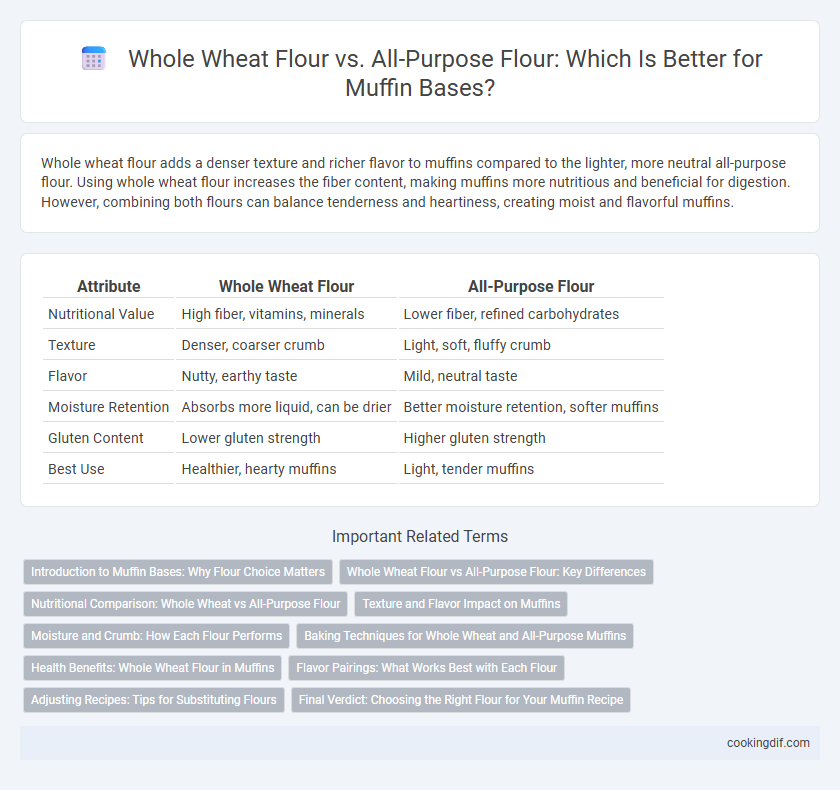Whole wheat flour adds a denser texture and richer flavor to muffins compared to the lighter, more neutral all-purpose flour. Using whole wheat flour increases the fiber content, making muffins more nutritious and beneficial for digestion. However, combining both flours can balance tenderness and heartiness, creating moist and flavorful muffins.
Table of Comparison
| Attribute | Whole Wheat Flour | All-Purpose Flour |
|---|---|---|
| Nutritional Value | High fiber, vitamins, minerals | Lower fiber, refined carbohydrates |
| Texture | Denser, coarser crumb | Light, soft, fluffy crumb |
| Flavor | Nutty, earthy taste | Mild, neutral taste |
| Moisture Retention | Absorbs more liquid, can be drier | Better moisture retention, softer muffins |
| Gluten Content | Lower gluten strength | Higher gluten strength |
| Best Use | Healthier, hearty muffins | Light, tender muffins |
Introduction to Muffin Bases: Why Flour Choice Matters
Whole wheat flour offers higher fiber content and a nuttier flavor, enhancing the nutritional profile and texture of muffins, while all-purpose flour provides a lighter crumb and more tender outcome due to its moderate protein level. The choice between whole wheat and all-purpose flour directly impacts muffin density, moisture retention, and flavor complexity, making it a critical decision for bakers aiming to balance healthfulness and palatability. Understanding the distinct characteristics of these flours allows for better customization of muffin recipes to suit dietary preferences and desired textural qualities.
Whole Wheat Flour vs All-Purpose Flour: Key Differences
Whole wheat flour contains higher fiber and nutrient content compared to all-purpose flour, making it a healthier choice for muffin bases. The denser texture of whole wheat flour results in a heartier, more filling muffin, while all-purpose flour produces a lighter, fluffier crumb. Choosing whole wheat flour enhances the nutritional profile of muffins without sacrificing taste, though it may require adjustments in moisture to prevent dryness.
Nutritional Comparison: Whole Wheat vs All-Purpose Flour
Whole wheat flour contains higher fiber content, more vitamins, and minerals compared to all-purpose flour, making it a healthier option for muffin bases. It retains bran and germ, which contribute to increased protein, iron, magnesium, and B vitamins, while all-purpose flour is more processed and lower in nutrients. Muffins made with whole wheat flour offer better satiety and a lower glycemic index, promoting improved digestion and stable blood sugar levels.
Texture and Flavor Impact on Muffins
Whole wheat flour creates denser and heartier muffins with a slightly nutty flavor, adding moisture but resulting in a coarser crumb compared to all-purpose flour. All-purpose flour produces lighter, fluffier muffins with a more neutral taste, allowing other flavors to shine through. Combining both flours can balance texture and flavor, offering a tender yet wholesome muffin base.
Moisture and Crumb: How Each Flour Performs
Whole wheat flour tends to retain more moisture in muffins due to its higher bran and germ content, resulting in a denser and more flavorful crumb. All-purpose flour produces a lighter, airier crumb with a softer texture because of its refined starches and lower fiber. The choice between whole wheat and all-purpose flour significantly impacts muffin moisture levels and crumb structure, with whole wheat offering a hearty chew and all-purpose providing classic tenderness.
Baking Techniques for Whole Wheat and All-Purpose Muffins
Whole wheat flour requires more moisture and longer mixing time to fully hydrate its bran and germ, preventing dense muffins. All-purpose flour produces a lighter, more tender crumb but can result in less nutritional value compared to whole wheat. Adjusting baking temperature and incorporating leavening agents like baking powder or baking soda ensures optimal rise and texture for both flour types in muffin recipes.
Health Benefits: Whole Wheat Flour in Muffins
Whole wheat flour in muffins provides higher fiber content and increased levels of essential nutrients such as vitamins B and E compared to all-purpose flour. Using whole wheat flour contributes to better digestive health and helps regulate blood sugar levels due to its lower glycemic index. This makes muffins made with whole wheat flour a healthier option for sustained energy and improved heart health.
Flavor Pairings: What Works Best with Each Flour
Whole wheat flour lends a nuttier, heartier flavor to muffins, pairing exceptionally well with ingredients like nuts, cinnamon, or fruits such as apples and bananas, which complement its earthy taste. All-purpose flour creates a milder, more neutral base, allowing delicate flavors like vanilla, lemon zest, or berries to shine without overpowering the muffin. Choosing the right flour depends on whether you want a robust, wholesome muffin or a light, tender crumb that highlights subtle flavor notes.
Adjusting Recipes: Tips for Substituting Flours
Whole wheat flour absorbs more liquid and results in denser muffins compared to all-purpose flour, so reduce the amount by about 10-15% and increase liquid ingredients when substituting. Incorporate baking powder or soda slightly above the standard amount to counteract whole wheat's heavier texture for optimal rise. For best results, combine whole wheat flour with all-purpose flour to balance fiber content and maintain moistness in muffins.
Final Verdict: Choosing the Right Flour for Your Muffin Recipe
Whole wheat flour offers higher fiber and nutrients, creating denser, heartier muffins, while all-purpose flour yields lighter, fluffier texture with neutral taste. Select whole wheat flour for healthier, more filling muffins and all-purpose for classic, tender crumb and broad appeal. Balancing nutrition and desired muffin texture guides the optimal flour choice for your recipe.
Whole wheat flour vs All-purpose flour for muffin base Infographic

 cookingdif.com
cookingdif.com